First Look: Samsung Galaxy S8
by Matt Humrick on April 21, 2017 8:55 AM EST- Posted in
- Smartphones
- Samsung
- Galaxy
- Mobile
- Snapdragon 835
- Galaxy S8
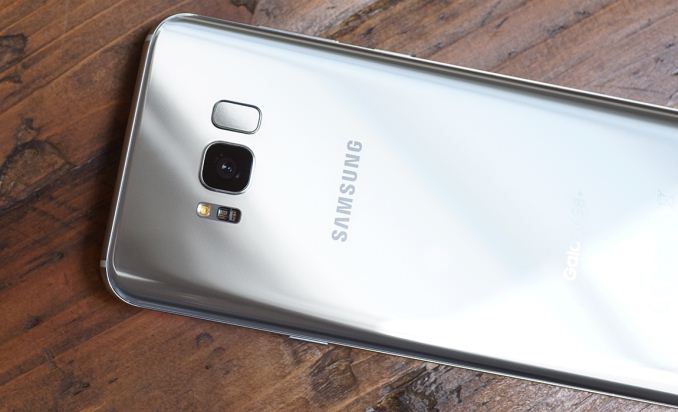
We first saw Samsung’s new 5.8-inch Galaxy S8 and 6.2-inch Galaxy S8+ at its Unpacked event a few weeks ago. During the event, we saw demos of its new virtual assistant, Bixby, and its DeX docking station, which allows the Galaxy S8 to provide a desktop-like experience by connecting to an external monitor and peripherals, but we didn’t have much time with the phones to do much more than take some pictures and try a couple of the new features. After receiving a Galaxy S8 earlier this week, we wanted to give you some feedback about its design and biometric features, as well as, an initial performance and battery life assessment before we dive into our usual in-depth testing.
My biggest complaint about the design is the location of the fingerprint sensor, which I discuss in the video above. It has been relocated to the back next to the camera, making it difficult to reach and use. The new face unlock feature, the second of the S8’s three biometric authentication options, is flawed too. Despite my best efforts, I was not able to get face unlock to work, not even once. The feature, which relies solely on the front-facing camera for identification, also is not very secure, assuming it works at all. It has already been shown that simply holding a picture in front of the camera is enough to fool it into unlocking the phone. The camera really needs to be augmented with an infrared camera to detect a face’s heat signature as a liveness test, or a second, depth-sensing camera to at least detect a face in three dimensions. So far the iris scanner, which I also demo in the video above, has proven to be the easiest and most reliable biometric option.
| Samsung Galaxy S8 Series | ||
| Samsung Galaxy S8 | Samsung Galaxy S8+ | |
| SoC | Qualcomm Snapdragon 835 (US, China, Japan) 4x Kryo 280 Performance @ 2.35GHz 4x Kryo 280 Efficiency @ 1.90GHz Adreno 540 Samsung Exynos 8895 (rest of world) 4x Exynos M2 @ 2.30GHz 4x Cortex-A53 @ 1.70GHz ARM Mali-G71 |
|
| Display | 5.8-inch 2960x1440 (18.5:9) SAMOLED (curved edges) |
6.2-inch 2960x1440 (18.5:9) SAMOLED (curved edges) |
| Dimensions | 148.9 x 68.1 x 8.0 mm 155 grams |
159.5 x 73.4 x 8.1 mm 173 grams |
| RAM | 4GB LPDDR4 (US) | |
| NAND | 64GB (UFS) + microSD |
|
| Battery | 3000 mAh (11.55 Wh) non-replaceable |
3500 mAh (13.48 Wh) non-replaceable |
| Front Camera | 8MP, f/1.7, Contrast AF | |
| Rear Camera | 12MP, 1.4µm pixels, f/1.7, dual-pixel PDAF, OIS, auto HDR, LED flash | |
| Modem | Snapdragon X16 LTE (Integrated) 2G / 3G / 4G LTE (Category 16/13) Samsung LTE (Integrated) 2G / 3G / 4G LTE (Category 16/13) |
|
| SIM Size | NanoSIM | |
| Wireless | 802.11a/b/g/n/ac 2x2 MU-MIMO, BT 5.0 LE, NFC, GPS/Glonass/Galileo/BDS | |
| Connectivity | USB Type-C, 3.5mm headset | |
| Features | fingerprint sensor, heart-rate sensor, iris scanner, face unlock, fast charging (Qualcomm QC 2.0 or Adaptive Fast Charging), wireless charging (WPC & PMA), IP68, Mobile HDR Premium | |
| Launch OS | Android 7.0 with TouchWiz | |
Inside the redesigned Galaxy S8 and S8+ is either a Qualcomm Snapdragon 835 or Samsung Exynos 8895 SoC. The US and other regions that require CDMA capability will get the Snapdragon 835, while the rest of the world will get Samsung’s SoC. The new 10nm SoCs are paired with 4GB of LPDDR4 RAM and 64GB of UFS 2.1 NAND. The Galaxy S8 comes with a 3000mAh battery, the same size as the Galaxy S7, while the S8+ comes with a 3500mAh battery, slightly less than the S7 edge’s 3600mAh capacity.
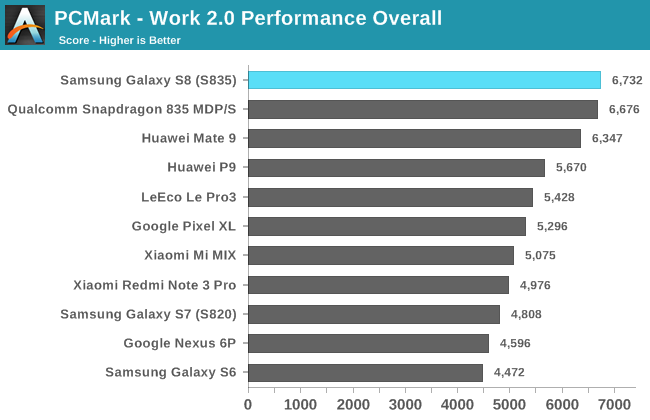
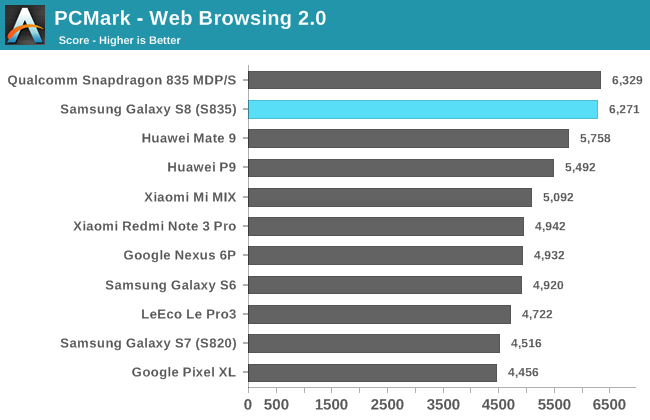
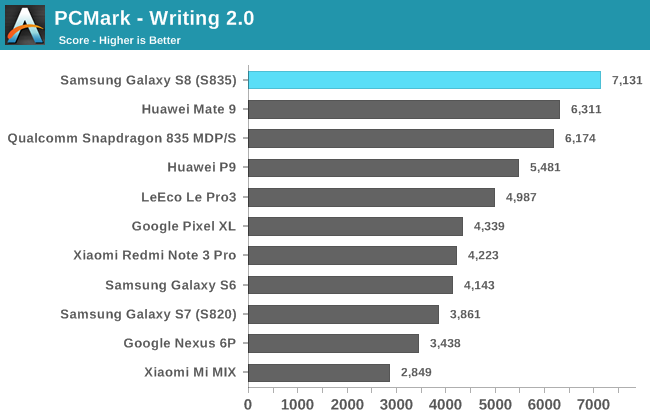
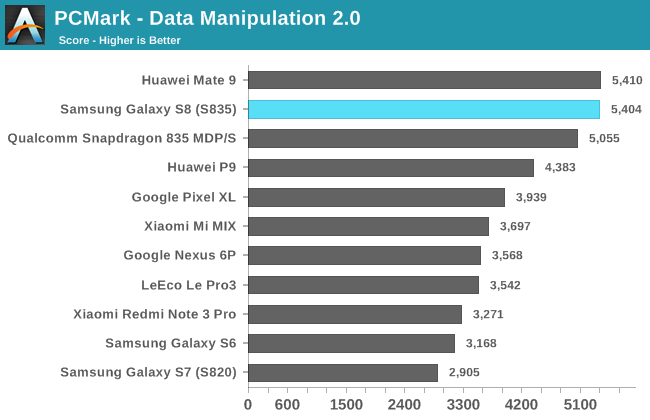
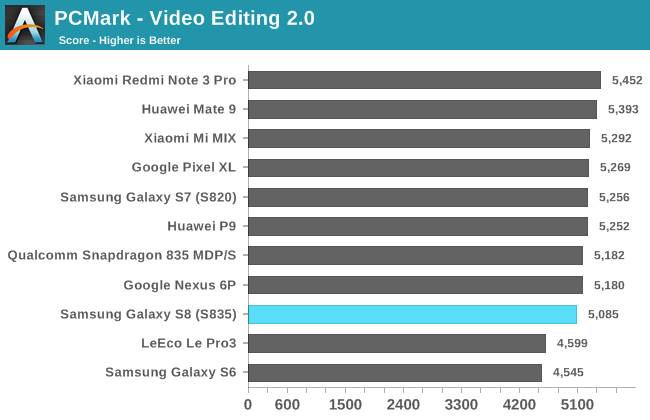
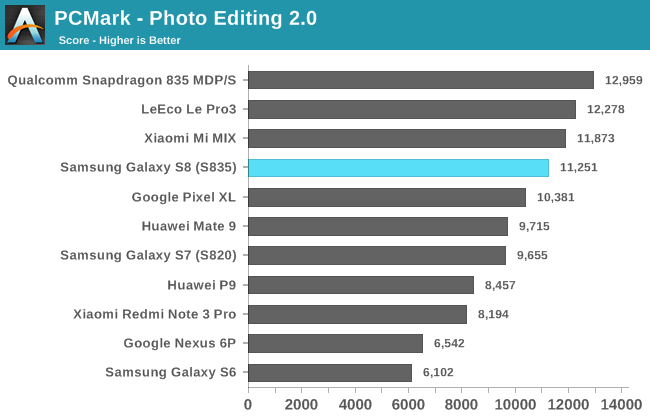
In PCMark, which is our best indicator of general system performance, the Galaxy S8 with Snapdragon 835 performs quite well, besting even the Mate 9 overall. Because this is the first S835 retail device we’ve tested, I’ve also included Qualcomm’s Snapdragon 835 MDP/S, which the company uses internally for hardware testing and software development, as a reference point. In most of these tests, the Galaxy S8 performs about the same as the Snapdragon 835 MDP/S, which is certainly a good sign.
The Galaxy S8 does particularly well in the Writing test, outscoring the Mate 9 by 13% and the Galaxy S7 (Snapdragon 820) by 85%. The Writing test, which previous Galaxy phones struggle with, uses a fairly bursty workload, frequently migrating threads between the little and big cores. Perhaps this is an indication that Samsung is utilizing the big cores more aggressively than in the past. The Galaxy S8 is also 9% faster than the Mate 9 in the Web Browsing test and 37% faster than the S7 (S820).

The Galaxy S8 achieves over 8 hours of screen-on-time while continuously crunching through the PCMark workloads, 46% longer than the Galaxy S7 that has the same 3000mAh battery, which suggests some nice efficiency gains from the new SoC, display, or other components. While the Galaxy S7 can struggle to last a full day on a single charge depending on how it’s used, these initial results suggest the Galaxy S8 will encounter fewer scenarios where it will need to use its fast charging or wireless charging abilities to stretch battery life till the end of the day.
While we’ve only had the Galaxy S8 for a couple of days, our first impression is generally positive. It’s packed with features, TouchWiz is more refined, and it performed well in our first performance and battery life tests. A few issues are already apparent, however. Your face probably will not be smiling if you try to rely on it to unlock the phone, and the fingerprint sensor is located in just about the worst possible place. Samsung’s Bixby assistant also is not yet fully functional; fortunately, you can still use Google Assistant while you’re waiting for Bixby to mature.










129 Comments
View All Comments
Chidoro - Sunday, April 23, 2017 - link
My Droid turbo is 2 1/2 years old and the battery life on it is still better than most new phones.Sure, it's a 3900 mah pack, but that's the whole point and one of the primary reasons why I purchased it.
trparky - Friday, April 21, 2017 - link
I am impressed, the software does look pretty damn polished when compared to years ago. However until both Samsung and the United States carriers agree to a guaranteed monthly software patch schedule which includes not only security patches but core Android updates I won't buy an Android phone.Windows, Linux, Google Chrome, and Firefox can all do monthly software updates and patches. Why the hell can't Samsung?!?!
lilmoe - Friday, April 21, 2017 - link
They.....do? I'm on the April security patch on my GS7e, my wife's Note 4 is on March's.phoenix_rizzen - Friday, April 21, 2017 - link
It depends on the carrier. Canadian GS7 is stuck on the Feb security release ATM, although we did just receive an update to Android 7.0.1 this month.anactoraaron - Monday, April 24, 2017 - link
And yet the US unlocked variants (SM-G930U and SM-G935U) are still on 6.0.1, March 2017 security patch, while just about every version of S6 and even the Note 5 are on 7.0. They recently promised monthly security patches (after releasing what was supposedly their last quarterly update) and yet here we are at the end of April and no April patch, and still no timeline on 7.0 or if we few unlucky souls will ever get 7.0 on this flagship device.So it depends on which version of flagship you own from Samsung as to whether you get updates and support.
My advise is to NEVER buy a US unlocked ANYTHING from Samsung. Ever.
m2inor - Wednesday, April 26, 2017 - link
I just got the S7 Edge 128GB unlocked. Came from UAE, and 7.0 was factory installed.Great phone, and dual-SIM, too.
You can peruse the Samsung UAE website for specs. Souq.com is a reseller but does not ship outside the local market; they use Amazon's online software, and Amazon is moving to purchase the business. There are US resellers over on eBay at good prices,a nd fast delivery, too.
lmcd - Friday, April 21, 2017 - link
Sadly, Windows Mobile just cut off the majority of its base from new updates. Linux has a major problem with distros failing to backport consistently. Google Chrome auto-updates on Windows and Mac, but uses the Linux repository system and in many ways isn't convenient to upgrade on Linux (in my opinion). Firefox updates are mostly smooth, but haven't managed to fix many of the problems that need updated.Nobody's perfect.
tuxRoller - Friday, April 21, 2017 - link
Looks like apple is!tuxRoller - Friday, April 21, 2017 - link
Um, you know that companies other than Samsung make Android devices?Some even provide guarantees regarding updates (iirc, Samsung actually announced an update policy for their phones this year).
frowertr - Friday, April 21, 2017 - link
The fingerprint sensor location in fine for those of us using a case. You can easily "feel" where the sensor is from the cutouts in the back of the case.